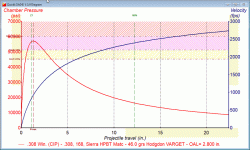I was talking with someone and they mentioned that even though there is a possible 62k psi max pressure in the 5.56 AR barrel . As the bullet passes the gas port the pressure would be more like 10k to 15k psi in a standard 5.56 load .
First does pressure drop that much in the barrel ? I knew your peak pressure was only a few inches down the bore but never thought the pressure dropped that much by the time the bullet left the muzzle .
Now I know there are a few variables in that equation so there is no straight answer but lets give a specific load and guess ( or if someone can run a quickloads calc ) what the pressure would be
Rifles : lets do two with gas ports 12" down the bore and 7" down the bore
1) standard M16A2 with 20" barrel and rifle length gas system
2) M4 14.5" barrel with carbine gas system
Load :
55gr FMJ-BT
26gr H-335
LC-12 case
CCI #41 primer
COAL 2.240
Any thoughts ?
Me ? I really have no idea but my first thought would have been 40k psi at the gas port but now I'm not sure .
First does pressure drop that much in the barrel ? I knew your peak pressure was only a few inches down the bore but never thought the pressure dropped that much by the time the bullet left the muzzle .
Now I know there are a few variables in that equation so there is no straight answer but lets give a specific load and guess ( or if someone can run a quickloads calc ) what the pressure would be
Rifles : lets do two with gas ports 12" down the bore and 7" down the bore
1) standard M16A2 with 20" barrel and rifle length gas system
2) M4 14.5" barrel with carbine gas system
Load :
55gr FMJ-BT
26gr H-335
LC-12 case
CCI #41 primer
COAL 2.240
Any thoughts ?
Me ? I really have no idea but my first thought would have been 40k psi at the gas port but now I'm not sure .

